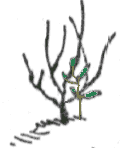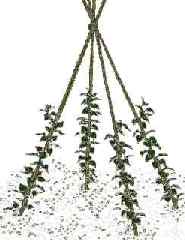Categories
Calendars
Guides
Reviews
Archive
Gallery
Articles
Ask Our Gardening Expert
Caring for French Beans
Dwarf
French Beans may not require support in good conditions.
However, the weight of the pods does tend to drag them to the
ground, attracting slugs and other pests. It is best to tie them
into a short bamboo pole or let them scramble through twigs
inserted into the ground next to them. This will also give some
protection to the plants if the weather conditions turn windy.
The
climbing varieties of French Beans grow to about 1.8m (6 foot)
high and they definitely need support. The idea is to provide a
structure which their tendrils can grow round and pull the plant
up. It is a good idea to twist some gardening twine round the bamboo
canes, this will give the growing plants more to grab hold of. Where
space is really short, this type of structure can be used for
container growing French beans. In this case, insert one cane
centrally in the container, tie six or so lengths of garden
twine to the top of the cane and secure the other ends of the
twine to the edge of the container. Plant three or four seeds,
which will then grow up the twine. The plants will need their
tips pinching out when they reach the top of the twine. Other methods are to erect a criss-cross of canes, each pair tied
together at the top, or simply a line of canes connected
together with mesh netting. Finally, don't forget that French
beans can be be grown up an existing fence which has been
covered with mesh netting. The requirements of French beans are simple - water and
weeding, possibly some feeding. All three can be greatly helped by
a mulch of organic material spread round the plants. This will
help retain moisture, keep the weeds down and gently feed the
plants. If the soil has been prepared as described previously
the only other attention is hand watering in very dry
conditions, especially as the flower buds begin to develop. A
special treat for French Beans is watering with Tomato Plant
food every couple of weeks if possible. Finally, pinch out the
growing tips when the plants reach the top of the supports. French Beans will be ready for harvesting in
July, and this should continue into early October. Pick the beans when
they are young - leaving them too long will result in a crop of
stringy beans. Length of the beans does not let you know if they
are ready, rely on the texture of the beans - they are past
their best when the skin is coarse textured and the beans inside
begin to show through like small marbles. To maximise the crop and the cropping period, pick the beans
frequently to encourage new beans to grow. Most French Beans seed write-ups claim to
be
suitable for freezing but in our experience they end up loosing all their texture
and crunch. French
Beans and Cooking They will keep in the fridge for 3 days or so. As for freezing, we
have found that French beans go mushy when frozen. Certainly, the excellent
varieties Twiggy and Goldukkat, do not freeze very well. We will be investigating
this further with different varieties over the next year or so. If
you do want to try freezing French beans, then
click here for
instructions.
Try or tasty French bean soup recipe by
clicking here. It's easy to make and
freezes extremely well. CLICK
HERE FOR NEXT PAGE![]()
Caring for French Beans
French Bean Care - Support

 The
most attractive form of support is a wigwam - four or five
bamboo canes tied together at the top will be sufficient. The
growth at the top will be a bit crowded, but this structure will
still produce a good crop of beans.
The
most attractive form of support is a wigwam - four or five
bamboo canes tied together at the top will be sufficient. The
growth at the top will be a bit crowded, but this structure will
still produce a good crop of beans.French Bean Care - Water and Feed
French
Bean Care - Harvest
French Beans are delicious straight from the garden. For a standard vegetable,
cook them in boiling water for about 10 to 12 minutes.
FRENCH
BEAN HOME PAGE || PREVIOUS
FRENCH BEAN PAGE